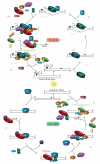True lies: the double life of the nucleotide excision repair factors in transcription and DNA repair
- PMID: 20725631
- PMCID: PMC2915888
- DOI: 10.4061/2010/616342
True lies: the double life of the nucleotide excision repair factors in transcription and DNA repair
Abstract
Nucleotide excision repair (NER) is a major DNA repair pathway in eukaryotic cells. NER removes structurally diverse lesions such as pyrimidine dimers, arising upon UV irradiation or bulky chemical adducts, arising upon exposure to carcinogens and some chemotherapeutic drugs. NER defects lead to three genetic disorders that result in predisposition to cancers, accelerated aging, neurological and developmental defects. During NER, more than 30 polypeptides cooperate to recognize, incise, and excise a damaged oligonucleotide from the genomic DNA. Recent papers reveal an additional and unexpected role for the NER factors. In the absence of a genotoxic attack, the promoters of RNA polymerases I- and II-dependent genes recruit XPA, XPC, XPG, and XPF to initiate gene expression. A model that includes the growth arrest and DNA damage 45alpha protein (Gadd45alpha) and the NER factors, in order to maintain the promoter of active genes under a hypomethylated state, has been proposed but remains controversial. This paper focuses on the double life of the NER factors in DNA repair and transcription and describes the possible roles of these factors in the RNA synthesis process.
Figures




Similar articles
-
Nucleotide excision repair in higher eukaryotes: mechanism of primary damage recognition in global genome repair.Subcell Biochem. 2010;50:251-77. doi: 10.1007/978-90-481-3471-7_13. Subcell Biochem. 2010. PMID: 20012586 Review.
-
Nucleotide excision repair: DNA damage recognition and preincision complex assembly.Biochemistry (Mosc). 2011 Jan;76(1):24-35. doi: 10.1134/s0006297911010056. Biochemistry (Mosc). 2011. PMID: 21568837 Review.
-
The comings and goings of nucleotide excision repair factors on damaged DNA.EMBO J. 2003 Oct 1;22(19):5293-303. doi: 10.1093/emboj/cdg489. EMBO J. 2003. PMID: 14517266 Free PMC article.
-
Exposure of Human Lung Cells to Tobacco Smoke Condensate Inhibits the Nucleotide Excision Repair Pathway.PLoS One. 2016 Jul 8;11(7):e0158858. doi: 10.1371/journal.pone.0158858. eCollection 2016. PLoS One. 2016. PMID: 27391141 Free PMC article.
-
Cell-type-specific consequences of nucleotide excision repair deficiencies: Embryonic stem cells versus fibroblasts.DNA Repair (Amst). 2008 Oct 1;7(10):1659-69. doi: 10.1016/j.dnarep.2008.06.009. Epub 2008 Jul 26. DNA Repair (Amst). 2008. PMID: 18634906
Cited by
-
Structural and functional characterization of interactions involving the Tfb1 subunit of TFIIH and the NER factor Rad2.Nucleic Acids Res. 2012 Jul;40(12):5739-50. doi: 10.1093/nar/gks194. Epub 2012 Feb 28. Nucleic Acids Res. 2012. PMID: 22373916 Free PMC article.
-
Nucleotide Excision Repair and Vitamin D--Relevance for Skin Cancer Therapy.Int J Mol Sci. 2016 Apr 6;17(4):372. doi: 10.3390/ijms17040372. Int J Mol Sci. 2016. PMID: 27058533 Free PMC article. Review.
-
Conservation of the nucleotide excision repair pathway: characterization of hydra Xeroderma Pigmentosum group F homolog.PLoS One. 2013;8(4):e61062. doi: 10.1371/journal.pone.0061062. Epub 2013 Apr 8. PLoS One. 2013. PMID: 23577191 Free PMC article.
-
ERCC1-XPF cooperates with CTCF and cohesin to facilitate the developmental silencing of imprinted genes.Nat Cell Biol. 2017 May;19(5):421-432. doi: 10.1038/ncb3499. Epub 2017 Apr 3. Nat Cell Biol. 2017. PMID: 28368372
-
Xeroderma pigmentosum and other diseases of human premature aging and DNA repair: molecules to patients.Mech Ageing Dev. 2011 Jun-Jul;132(6-7):340-7. doi: 10.1016/j.mad.2011.06.004. Epub 2011 Jun 25. Mech Ageing Dev. 2011. PMID: 21708183 Free PMC article. Review.
References
-
- Hoeijmakers JHJ. DNA damage, aging, and cancer. The New England Journal of Medicine. 2009;361(15):1475–1485. - PubMed
-
- Svejstrup JQ. The interface between transcription and mechanisms maintaining genome integrity. Trends in Biochemical Sciences. 2010;35(6):333–338. - PubMed
-
- Schumacher B, Garinis GA, Hoeijmakers JHJ. Age to survive: DNA damage and aging. Trends in Genetics. 2008;24(2):77–85. - PubMed
-
- Kamenisch Y, Berneburg M. Progeroid syndromes and UV-induced oxidative DNA damage. Journal of Investigative Dermatology Symposium Proceedings. 2009;14(1):8–14. - PubMed
-
- Lehmann AR. DNA repair-deficient diseases, xeroderma pigmentosum, Cockayne syndrome and trichothiodystrophy. Biochimie. 2003;85(11):1101–1111. - PubMed
LinkOut - more resources
Full Text Sources

